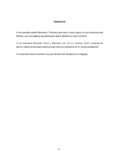| dc.contributor.author | Díaz Mejía, Alicia G. | |
| dc.date.accessioned | 2014-10-20T04:36:07Z | |
| dc.date.available | 2014-10-20T04:36:07Z | |
| dc.date.issued | 2003 | es_ES |
| dc.identifier | 365860 | es_ES |
| dc.identifier.uri | https://repositorio.catie.ac.cr/handle/11554/4775 | |
| dc.description | Tesis (M. Sc) -- CATIE, Turrialba (Costa Rica), 2003 | es_ES |
| dc.description.abstract | Con el objetivo de desarrollar y evaluar metodologías para la identificación rápida de resistencia a la Sigatoka negra en cultivares de plátano, se realizaron pruebas de patogenicidad tanto en invernadero como in vitro. En condiciones controladas de invernadero, para la identificación de la cepa de M. fijiensis con mayor nivel de virulencia, se utilizó el método estándar sobre los cultivares de plátano FHIA-21 (resistencia) y curraré (susceptible), siguiendo la inoculación artificial de 10 cultivos monospóricos de M. fijiensis, provenientes de diferentes regiones de Costa Rica. La cepa seleccionada como virulenta fue utilizada tanto en la verificación del método estándar como en el método de células del mesófilo bajo condiciones in vitro sobre estos mismos cultivares. Este último método, requirió la extracción de la fracción cruda de M. fijiensis (FcMF) y el establecimiento de un gradiente de dilución de FcMf con incubación a 25 m más menos 1 °C durante 24, 48 y 72 horas. En términos de consistencia, reproducibilidad y confiabilidad en los resultados se concluye que el método estándar se mantiene como el mejor frente al de células del mesófilo, este último es muy rápido pero, aún requiere de más estudios. | es_ES |
| dc.description.abstract | Pathogenic tests were done in a greenhouse as well as in vitro with the objective of developing and evaluating methodologies to rapidly identify the resistance of the Black Sigatoka in plantain cultivars. In controlled greenhouse conditions, standard methods for plantain cultivars FHIA-21 (resistant) and Curraré (susceptible) were used following the artificial inoculation of 10 M. fijiensis monosporic culture from different regions of Costa Rica to identify the M. fijiensis strain with the highest level of virulence. The strain selected as virulent was used to verify the standard method as well as the mesophyll cells method under in vitro conditions for the same cultivars. The latter method required the extraction of the crude M. fijiensis (FcMf) filtrate and the establishment of a dilution gradient for FcMf incubated at 25 more, less 1°C during 24, 48, and 72 hours. In terMON of consistency, reproduction, and confidence in the results, it was concluded that the standard method was the best for the mesophyll cells method. The latter is very fast, but it requires more studies. | |
| dc.format.extent | 66 páginas | |
| dc.language.iso | es | es_ES |
| dc.publisher | CATIE, Turrialba (Costa Rica) | es_ES |
| dc.subject | FUNGAL DISEASES | |
| dc.subject | PATHOGENICITY | |
| dc.subject | SIEVING | |
| dc.subject | INOCULATION | |
| dc.subject | METHODS | |
| dc.subject | DISEASE RESISTANCERESISTENCIA A LA ENFERMEDAD | |
| dc.subject | MUSA (PLATANOS) | |
| dc.subject | MYCOSPHAERELLA FIJIENSIS | |
| dc.subject | ENFERMEDADES FUNGOSAS | |
| dc.subject | PATOGENICIDAD | |
| dc.subject | TAMIZADO | |
| dc.subject | MUSA (PLANTAINS) | |
| dc.subject | INOCULACION | |
| dc.subject | METODOS | |
| dc.title | Desarrollo y evaluación de métodos para tamizado temprano de resistencia a Mycosphaerella fijiensis Morelet, en cultivares de plátano | es_ES |
| dc.title.alternative | Development and evaluation for early resistance selection to Mycosphaerella fijiensis Morelet, in plantain cultivars | es_ES |
| dc.type | Tesis de maestría | es_ES |
| dcterms.rights | acceso abierto | es |
| dc.identifier.publication | Turrialba (Costa Rica) | es_ES |


